#4th c bce
Text
[Hanfu · 漢服]Chinese immortal Hanfu <西王母/Queen Mother of the West> Based On Yuan Dynasty Taoist Temple Mural<永乐宫/Yongle Palace>
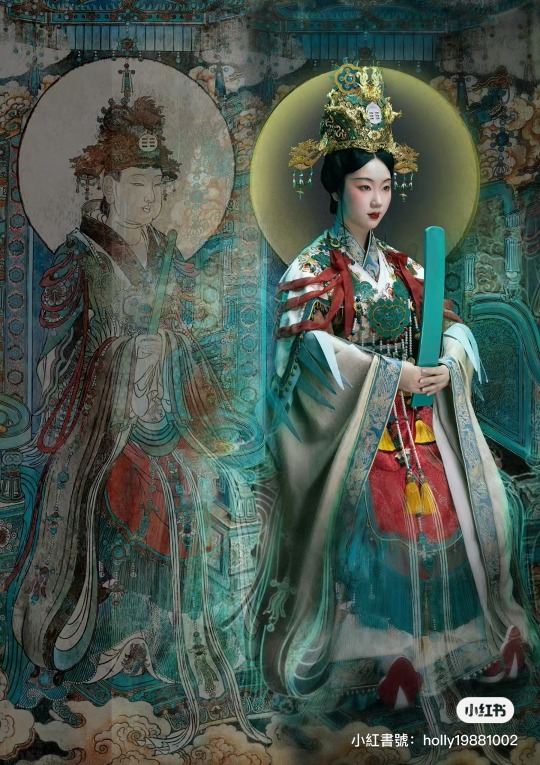
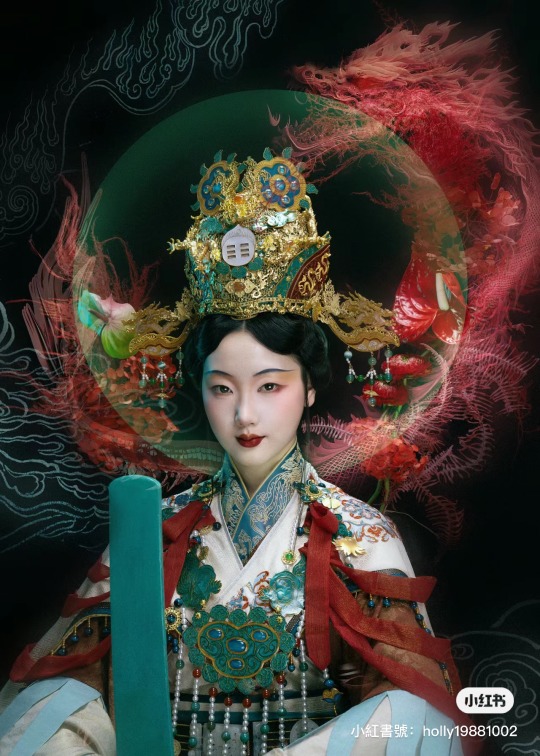
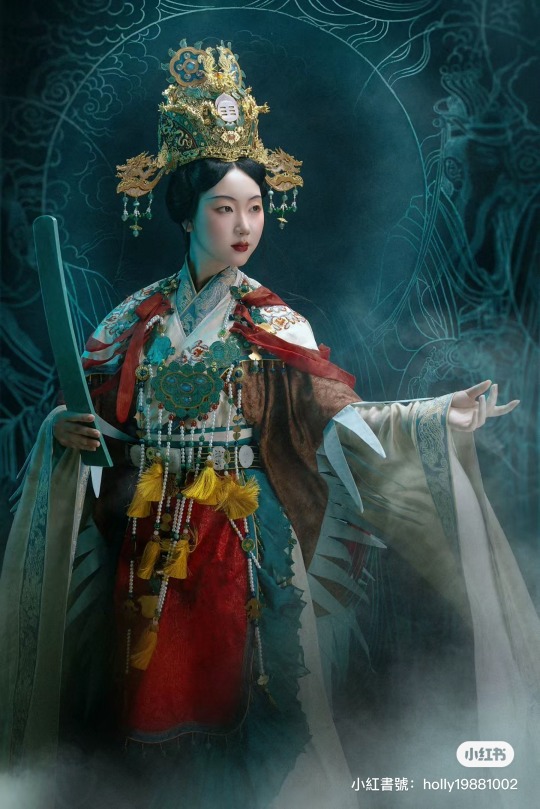
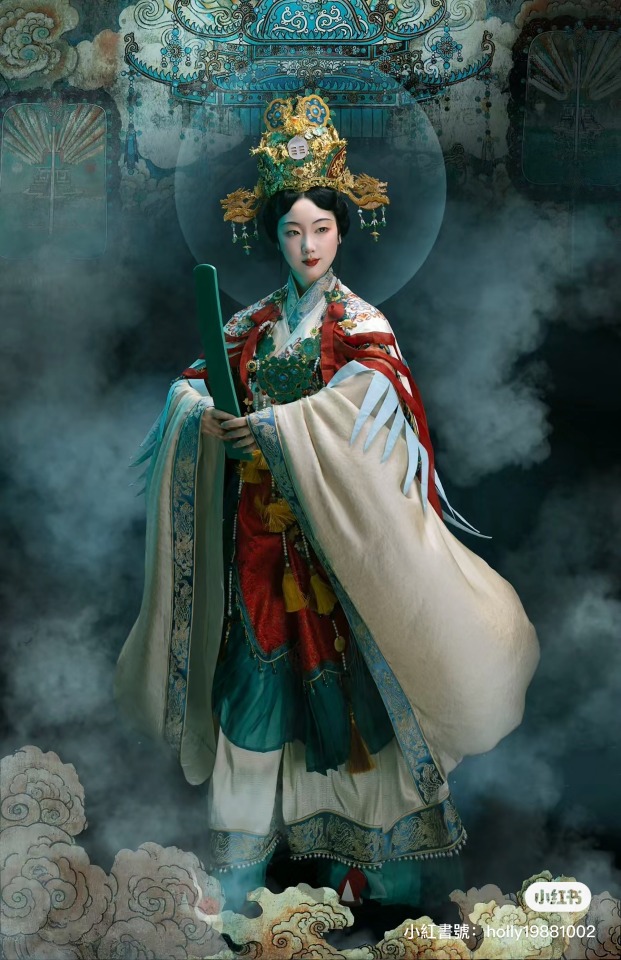
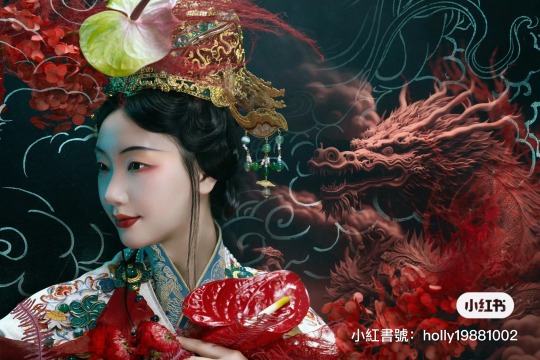
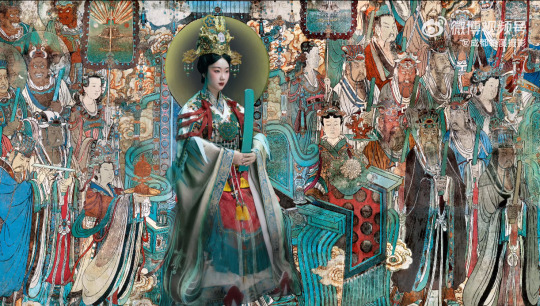
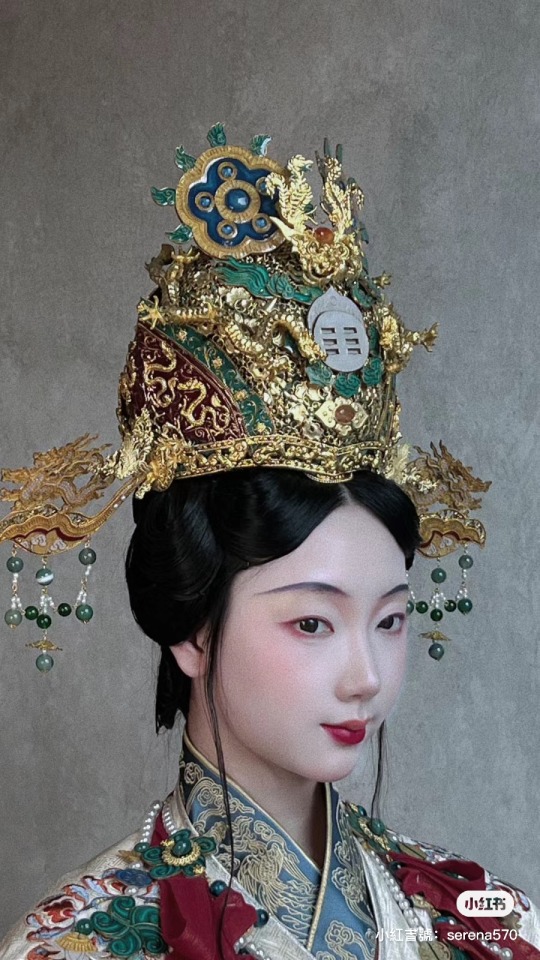
【Historical Artifacts Reference 】:
▶ China Yuan Dynasty Taoist Temple 永乐宫/Yongle Palace Mural


<西王母/Queen Mother of the West>
The Queen Mother of the West, known by various local names, is a mother goddess in Chinese religion and mythology, also worshipped in neighbouring Asian countries, and attested from ancient times.
The first mentions of the Queen Mother date back to the oracle bone inscriptions of the Shang dynasty (1766 – 1122 BCE).
One inscription reads:
Crack-making on day IX (9th day), we divined. If we make offering to the eastern mother and the western mother, there will be approval.
Western Mother refers to an archaic divinity residing in the west. The exact nature of the Mother divinities in the Shang dynasty is unclear, but they were seen as powerful forces deserving of ritual by the people of the Shang dynasty.
Originally, from the earliest known depictions of her in accounts like the Classic of Mountains and Seas during the Zhou dynasty, she was a ferocious goddess of death with the teeth of a tiger, who rules over wild beasts and sends down heavenly punishments such as pestilences. She was also mentioned as an authority ruling over other divinities such as Jiutian Xuannü, a goddess of war and sex.
Other stories hold that she is a mountain goddess or a divine tigress. She is also popularly thought to have blessed the Eight Immortals with their supernatural abilities.
After her integration into the Taoist pantheon, she gradually took on associations with other aspects, such as immortality, as well.
The Queen Mother of the West is most often depicted holding court within her palace on the mythological Mount Kunlun, usually supposed to be in western China (a modern Mount Kunlun is named after this). Her palace is believed to be a perfect and complete paradise, where it was used as a meeting place for the deities and a cosmic pillar where communications between deities and humans were possible.At her palace she was surrounded by a female retinue of prominent goddesses and spiritual attendants. One of her symbols is the Big Dipper.
Although not definite there are many beliefs that her garden had a special orchard of longevity peaches which would ripen once every three thousand years,others believe though that her court on Mount Kunlun was nearby to the orchard of the Peaches of Immortality. No matter where the peaches were located, the Queen Mother of the West is widely known for serving peaches to her guests, which would then make them immortal. She normally wears a distinctive headdress with the Peaches of Immortality suspended from it.
Flourishing parasols, we reach the chronograms' extremity;
Riding on the mist, I wander to Lofty Whirlwind Peak.
The Lady of the Supreme Primordial descends through jade interior doors;
The Queen Mother opens her Blue-gem Palace.
Celestial people—What a Crowd!
A lofty meeting inside the Cyan Audience Hall.
Arrayed Attendants perform Cloud Songs;
Realized intonations fill the Grand Empty Space.
Every thousand years, her purple crabapple ripens;
Every four kalpas, her numinous melon produces abundantly.
This music differs from that at the feast in the wilderness—
So convivial, and certainly infinite.— Wu Yun (Complete Tang Poems 1967, line 4942)
One of the earliest written references to the Queen Mother comes from the writings of the Taoist writer Zhuangzi (c. 4th century BCE):
The Queen Mother of the West obtained it [the Dao]... ...and took up her seat at Shao kuang. No one knows her beginning; no one knows her end.
Zhuangzi describes the Queen Mother as one of the highest of the deities, meaning she had gained immortality and celestial powers. Zhuangzi also states that Xiwangmu is seated upon a spiritual western mountain range, suggesting she is connected to not only the heavens, but also to the west.
Legendary encounters
In Tu Kuang-ting's text, he includes narrative accounts of the Queen Mother's encounters with legendary Chinese heroes. One such account narrates an encounter between the Queen Mother and Laozi (Lord Lao):
"In the 25th year of King Chao of the Chou dynasty (1028 BCE) …"
"…Lord Lao and the realized person Yin Hsi went traveling…"
"…on their behalf, the Queen Mother of the West explicated the Scripture of Constant Purity and Quiet."
In this account, the Queen Mother plays the role of Laozi's superior and is credited with the ultimate authorship of the Dao De Jing. This dichotomy of the Queen Mother as the superior is a characteristic of Shangqing Taoism, a goddess worshiping sect of Taoism of which Tu Kuang-ting was a master. There is also an account of a meeting between the Queen Mother and Laozi in Tang poetry.[18] This account however, being of traditional Taoist thought, has the Queen Mother taking an inferior role to Laozi, calling him "Primordial Lord" (the title of his highest manifestation) and pays homage to the sage.

<China Han Dynasty stone-relief showing 西王母/Queen Mother of the West from Sichuan,China>

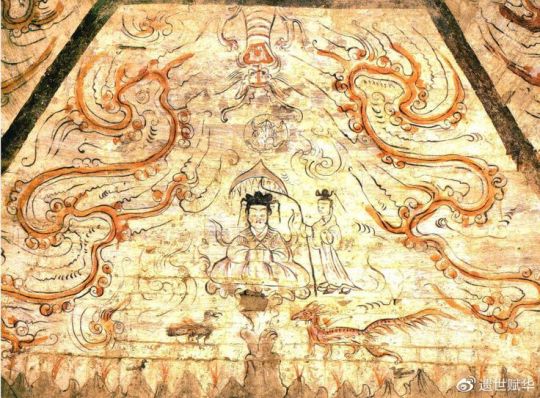
<China Wei and Jin Dynasties Mural showing 西王母/Queen Mother of the West>
————————
📸Photography post-production :@小何力
👗Hanfu & 👑Crown:@雁鸿Aimee
💄 Makeup:百丽 (临溪摄影)
👭Model:@清音音音音
🔗 Weibo:https://weibo.com/1648616372/O2R5bpBud
————————
#chinese hanfu#immortal hanfu#西王母/Queen Mother of the West#Chinese mythology#hanfu#hanfu accessories#hanfu_challenge#chinese traditional clothing#china#chinese#chinese history#china history#漢服#汉服#中華風#小何力#雁鸿Aimee#永乐宫/Yongle Palace
228 notes
·
View notes
Text
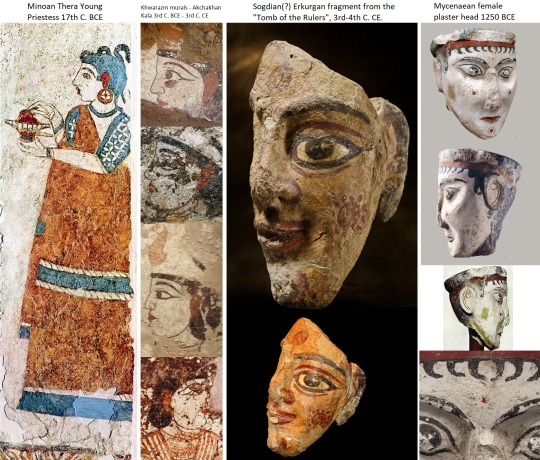
Comparison of Minoan, Mycenaean, Sogdian, & Khwarazm artworks 17th C. BCE - 4th C. CE
When I came across the Khwarazm (aka Chorasmian) murals I remembered this red-eared priestess from Thera. Their large eyebrows, red-painted ears, extremely light skin tone, and general facial features look very similar to each other despite being over 1,000 years apart and in different regions of the world. Other than that their clothing, jewelry, and hairstyle are quite different. I couldn't figure out what the significance of the red ears were, though Jason Earle speculates it might be an artistic depiction of a person hearing something divine from a deity (Cosmetics and Cult Practices in the Bronze Age Aegean? A Case Study of Women with Red Ears). These are the only images I've come across, that I can recall, of people with their ears painted red so I felt like comparing them.
The Erkurgan fragment has red solar symbols very similar to the Mycenaean plaster head. Again these two pieces of art are over 1,000 years apart and in different geographic locations. I don't know who the Erkurgan fragment should be attributed to, but this was a place in the heart of Sogdiana. I assume it represents a Sogdian because of location and time period, but that's just my assumption. Solar symbols appear in basically all civilizations, but I've never come across these specific red styled ones (that I can recall) except in these two instances. In both instances they appear on the cheeks, forehead, and probably the chin (the Erkurgan fragment's chin is damaged but seems to have some red paint). Again, seeing this unique symbol made me feel I should compare the two. From what I've read all the images here are generally thought to be depictions of females with religious significance.
#minoan#mycenaean#art history#ancient history#ancient#art#antiquities#history#paganism#pagan#goddess#priestess#indo european#ancient art#archaeology#anthropology#sogdiana#ancient greece
272 notes
·
View notes
Text

The piercing gaze of the ancient Greeks.
A collection of some famous Greek sculptures looking directly at...you
From left to right:
1) Antikythera Philosopher, 250 BCE
2) Athena of Piraeus, 4th century BCE
3) Head of Hygeia, 5th-4th cen. BCE
4) Antikythera Ephebe, 4th cent. BCE
5) Unknown man from Delos, c. 100
BCE
6) Head of a Goddess, 2nd cent. CE
📸 ArysPan
#dark academia#light academia#academia aesthetic#classical#academia#escapism#classic literature#books#books and libraries#architecture#greek#statue#sculpture#eyes#antikythera#Athena of Piraeus#Head of Hygeia#royal core#cottage core#aesthetic
904 notes
·
View notes
Photo

Laocoön: The Suffering of a Trojan Priest & Its Afterlife
The sculpture group of Laocoön and His Sons, on display in the Vatican since its rediscovery in 1506, depicts the suffering of the Trojan prince and priest Laocoön (brother of Anchises) and his young sons Antiphantes and Thymbraeus and is one of the most famous and fascinating statues of antiquity. In his Natural History, Pliny the Elder states that the Laocoön, created by the eminent Rhodian sculptors Hagesander, Polydorus, and Athenodorus, “is a work of art to be preferred to any other painting or statuary” (36.37). Among art historians, the sculptural group has received near-universal acclaim ever since its rediscovery under questionable circumstances in 1506.
Is the statue famously shown since its discovery in the newly designed Belvedere Garden at the Vatican Palace actually the ancient sculpture mentioned by Pliny, or rather a clever Renaissance forgery? If the latter, who may have contrived this masterful deception? If the former, is it an original, or a marble copy of a Hellenistic bronze made for a Roman patron?
Beware of Greeks Bearing Gifts
In the most famous version of the story, as told by Virgil (70-19 BCE) in his Aeneid, Laocoön had warned his fellow citizens against the Greeks “even if they bear gifts,” and had tried to expose the true nature of the wooden horse by striking it with a spear (the wooden horse in question, of course, being the notorious “Trojan Horse”, left by the Greek forces on the coast so as to provide access into the city to the troops hidden inside the construction). When later two serpents emerged from the sea to kill the priest and his sons, the Trojans interpreted their horrific deaths as an act of divine retribution and promptly decided to move the wooden horse into the city, believing the contraption to be an offering to Minerva (Athena).
According to Arctinus of Miletus, the earliest tradition of the tragedy (surviving only through later citations), Apollo had sent the two serpents to kill Laocoön and only one of his sons; while the later author Quintus of Smyrna maintains that the serpents killed both sons but spared the father.
Servius, another late authority (c. 400 CE), tells us how Laocoön managed to incur the wrath of Apollo by sleeping with his wife before the cult statue in the god's temple. An even later source, the Byzantine scholar Tzetzes, adds that the scene of Laocoön's death took place in the very temple of the Thymbraean Apollo – appropriately setting the punishment at the scene of the crime.
The 5th-century BCE Greek playwright Sophocles produced a tragedy on the subject, of which only a few fragments survive in later citations. Apart from the sources mentioned above, Hellenistic poets Apollodorus and Euphorion, the historian Dionysius of Halicarnassus, the Roman novelist Petronius, the Latin fables attributed to Hyginus, and a few other fragments, all provide various details of the tragic story.
Despite this appearance in ancient literature from the post-Homeric to Byzantine traditions, artistic representations of Laocoön's suffering are few and far between. Depictions appear in some Greek vase paintings (5th to 4th centuries BCE) and in two frescoes at Pompeii (c. 25-75 CE). The marble statue group of Laocoön and His Sons, therefore remains the most exceptional portrayal of only a handful of ancient works illustrating the suffering of Laocoön.
Continue reading...
59 notes
·
View notes
Text



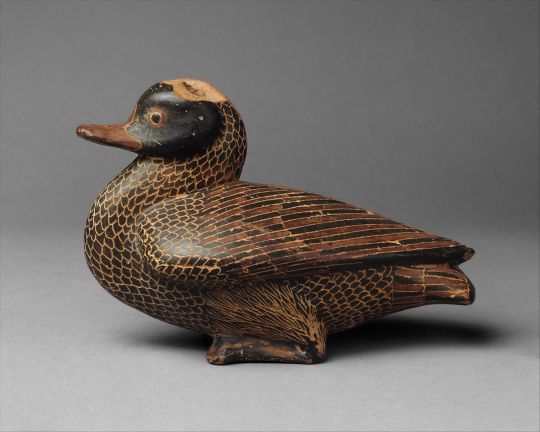


Terracotta askos (flask) in the form of a rooster, Etruscan 4th century BCE.
Heron-Shaped Figure Vase (Oil Vessel), East Greek, probably Milesian c. 580 BC
Protocorinthian terracotta vase in the form of a bird, mid-7th century BCE.
Archaic terracotta vase in the form of a duck, East-Greek mid-6th century BCE.
Terracotta askos (flask) in the form of a jackdaw, Etruscan 4th century BCE.
Swan Vase (perfume container), 575-550 BCE Greece, probably from Rhodes
367 notes
·
View notes
Text
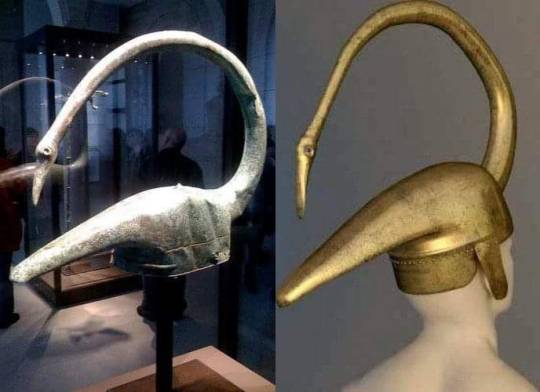
A Gallic bronze helmet in the shape of a swan.
Dated to c. 4th - 2nd century BCE, it was discovered in 2004 by archaeologists in Tintignac, France.
499 notes
·
View notes
Text
#InternationalSnowLeopardDay: The mythical winged snow leopard on the mountain, now a national symbol of Kazakhstan.

badge from The Golden Warrior burial
Issyk kurgan, ca. 4th-3rd c. BCE
stamped & engraved gold 7.2 × 8.5 cm
National Museum of of the Republic of Kazakhstan collection
#Kazakh art#Central Asian art#Asian art#National Museum of the Republic of Kazakhstan#Golden Man#Golden Warrior#Winged Snow Leopard#Snow Leopard#feline#ancient art#gold#metalwork#funerary art#Snow Leopard Day#International Snow Leopard Day#animal holiday#animals in art#Issyk kurgan#Kazakhstan#national symbol
82 notes
·
View notes
Text


Male Head from a Pediment Statue, perhaps of Dionysus/Bacchus; late 4th - early 3rd c BCE, terracotta | Found in the Auguratorium on the Palatine hill | Held in the Palatine Museum
#ancient art#unfortunately unknown if roman or greek or even etruscan#roman art#ancient greek art#etruscan art#?#roman terracotta#auguratorium#palatine museum#roman relief#dionysus
137 notes
·
View notes
Text
Yu the Great and Sun Wukong's Staff
This is my answer to the following reddit question:
Did the Ruyi Jingu Bang, as a tool used by Da Yu, exist before the novel?
Monkey's golden-hoop iron staff can be traced to the khakkhara and iron rod respectively used by his precursor in the 13th-century JTTW. The story doesn't mention anything about Yu the Great. The demi-god's connection to the staff is, as far as I know, unique to the standard 1592 edition of JTTW.
This association probably came about in a couple of ways. For example, there is a Chinese graphic similarity (and possible totemic connection) between Yu and a specific kind of monkey:
The generic Chinese primate names have identical pronunciations or spellings to those of the earliest Chinese emperors. For instance, the character 猱 (Nao) is considered as the ancestral name of the royal family of Shang dynasty (商朝 ca. 1600–1050 BCE) (Cao, 1997; Wang, 2001). This word is used to denote a primate species that is good at climbing. Similarly, the character 禺 (Yu) represents a long-tailed monkey. This word is the same as the character 禹 (Yu), a legendary emperor well known for his brilliance in regulating floodwater (Huang, 2011). This association between primates and the earliest emperors indicates a possible totemic status for primates (Niu, Ang, Xiao, et al., 2002, p. 91).
(The aforementioned Yu (禺) monkey was apparently well-known, for it is referenced several times in the Classic of Mountains and Seas (Shanhai jing, 山海經, c. 4th-century to 1st-century BCE), a popular Chinese bestiary, in order to indicate the shape and size of certain primate-like animals (Strassberg, 2002, pp. 83, 84, 91, 99, 104, 122, 123).)

Also, Yu is known for imprisoning Wuzhiqi (無支奇 / 巫支祇), a monkey flood demon, beneath a mountain in Tang and Song-era folklore. This likely influenced Sun Wukong's punishment under Five Elements Mountain.
Therefore, all of this probably led to the author-compiler of the 1592 JTTW associating Monkey's staff with Yu the Great and his efforts to end the world flood.
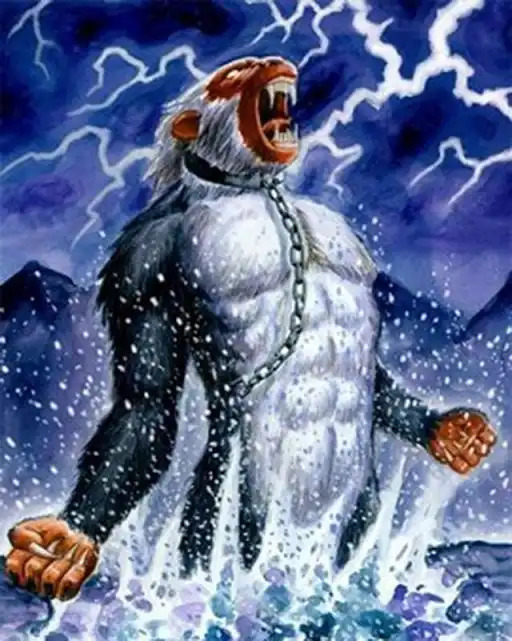
Sources:
Niu, K., Ang, A., Xiao, Z. et al. (2002). Is Yuan in China’s Three Gorges a Gibbon or a Langur? International Journal of Primatology, 43, 822–866. https://doi.org/10.1007/s10764-022-00302-1
Strassberg, R. (2002). A Chinese Bestiary: Strange Creatures from the Guideways Through Mountains and Seas. University of California Press.
#Da Yu#Yu the Great#Sun Wukong#Monkey King#Journey to the West#JTTW#Wuzhiqi#flood demon#monkey#Shanhaijing#Classic of Mountains and Seas#Magic Staff#Ruyi jingu bang#Gold-banded staff#Lego Monkie Kid#LMK
53 notes
·
View notes
Text

Sprinkler flask - Roman, 4th c BCE
82 notes
·
View notes
Text
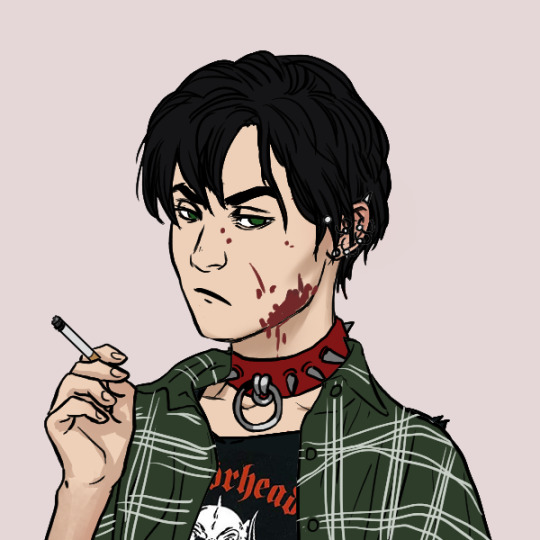
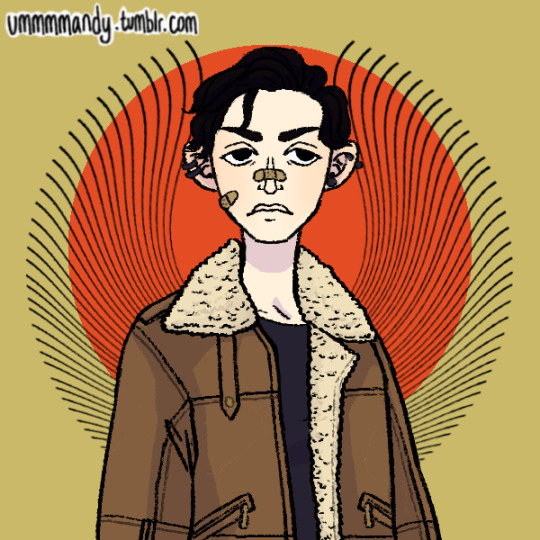





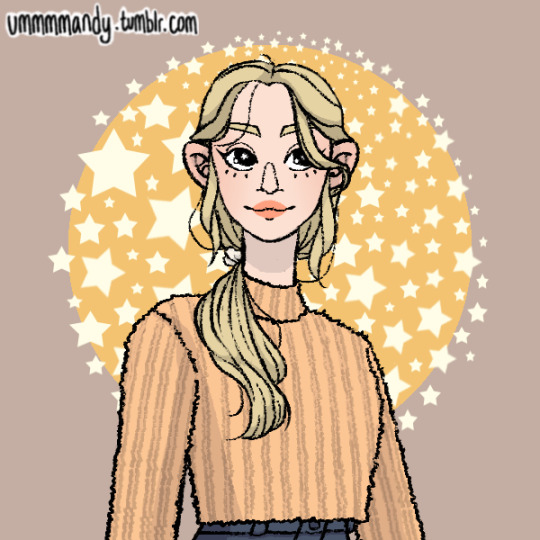

tagged variously by @corvosattano, @inafieldofdaisies, @carlosoliveiraa, and @socially-awkward-skeleton to do these picrews (picrew 1 | picrew 2 | picrew 3) and some uquizzes (linked below)
deputy sybille la roux (fc5) | paola orsini (uncharted) | saoirse monaghan (c*d)

How Fandom Would See You If You Were A Fictional Character
tragic. You're the sympathetic villain who does not-quite-bad-enough-stuff-to-be-hated for a very good reason. And you're redeemed by dying. Everyone's angry about it, you could have had an amazing redemption arc if you lived.
well, fortunately for syb's fictional fanbase, i know how dissatisfying the "redemption via death" is and it's exactly why she lives (despite her best efforts) and reaches that healing arc where she starts facing her sins and making amends rather than wallowing in misery.
which philosophical view are you?
cynicism (ca. 4th century bc). you feel alone; a sickening loneliness that is stuck in your bones. you are proud to be alone, to be the dog. they don't understand you, they never have, you are one of a kind. you yearn to be touched and to be loved, but you do not let yourself have it; if you love, you risk losing it. and you are tired of losing.

How Fandom Would See You If You Were A Fictional Character
mentor. You might not be the main character, but you're still very important. You're the older, or at least wiser one, who guides all those little youngins to victory. They may not always listen to you, but at least they respect you. The fandom looks on you as either a MILF/DILF, the lovable cooky old guy, or the one who really, really needs a break. Maybe all three. Probably all three.
i mean. she was literally a university professor and teacher (altho she was also the kind of instructor who has made students cry, but it usually came from a place of "i know you can do better.")
which philosophical view are you?
mazdakism (late 5th century CE). you are too kind, my friend. too loving, too giving towards people who don't deserve it. at some point you will run out of things to give, and you will start giving pieces of yourself. you wish they would give too; you wish for your selflessness to be repaid, to be acknowledged. but if you never write your name on the card, how will they know the gift came from you?

How Fandom Would See You If You Were A Fictional Character
mom friend. You're the character who carries snacks, who takes care of the rest of the cast. You make sure they eat, stop them from dying, and keep them out of trouble as best you can. and when they do get into trouble, you try your best to get them out of it. Good on you, dude.
*f;lkasjfda;lsdfjkd ok this is a funny result because while saoirse is just as reckless and willing to throw herself into danger as the boys are, she would get mischaracterized by fandom as the mom friend because 1) she is prepared, 2) she's compassionate, and 3) she's a woman. so.
which philosophical view are you?
british empiricism (17th - 18th century BCE). you feel too much and sense too little. no one is ever around when you break, you keep it to yourself. you think they don't notice, but the pain sticks to you like tar and the smell fills every room you enter. but you would never let them hold you, you're afraid it might be contagious.
tagging back for any picrews/uquizes you haven't done yet, and also tagging: @marivenah, @cassietrn, @trench-rot, @harmonyowl, @fourlittleseedlings, @purplehairsecretlair, @aceghosts, @adelaidedrubman, @finding-comfort-in-rain, @voidika, @locustandwildhoney, @testyfestyenthusiast, @strangefable, @alexxmason, @deputyash, @josephslittledeputy, and anyone else wanting to do any of these! (taglist opt in/out)
#woof ok this was a big ol roundup#please enjoy some girls#oc: deputy sybille la roux#oc: paola orsini#oc: saoirse monaghan
32 notes
·
View notes
Text


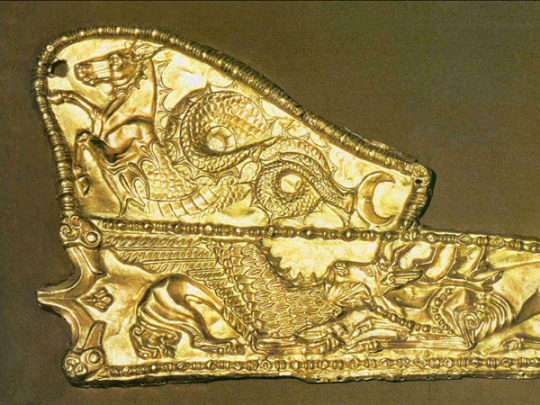
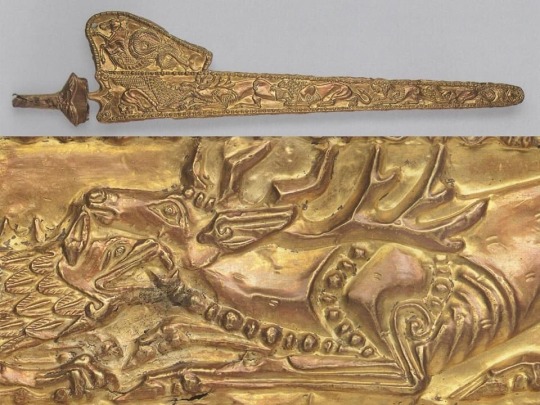
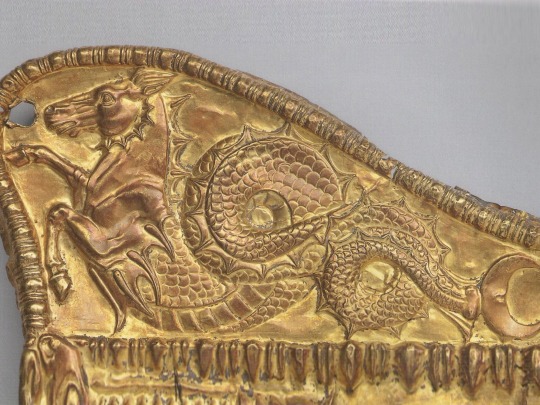
Scythian sword scabbard with hippocampus, griffin, and animals 4th C. BCE. Here is the figure caption from the Hermitage: Overlay for a sword scabbard, Created Scythian culture, 350 - 325 BCE. Place of finding: Dnieper region near Nikopol.
#scythian#scythian gold#scythian mythology#sword#scabbard#art#ancient art#ancient#pagan#paganism#antiquities#museums#artifacts#4th century bce
751 notes
·
View notes
Photo

Glass oinochoe (perfume jug). late 4th–early 3rd century BCE. Credit line: Edward C. Moore Collection, Bequest of Edward C. Moore, 1891 https://www.metmuseum.org/art/collection/search/245769
#aesthetic#art#abstract art#art museum#art history#The Metropolitan Museum of Art#museum#museum photography#museum aesthetic#dark academia
20 notes
·
View notes
Photo

Cyrenaics
The Cyrenaics were a philosophical school of thought founded c. 4th century BCE by Aristippus of Cyrene (l. c. 435-356 BCE) who taught that sensual pleasure was the highest good and only worthwhile pursuit in life. Known as the first hedonistic school, Cyrenaicsim was eventually replaced by the more comprehensive philosophy of Epicureanism.
Continue reading...
105 notes
·
View notes
Text

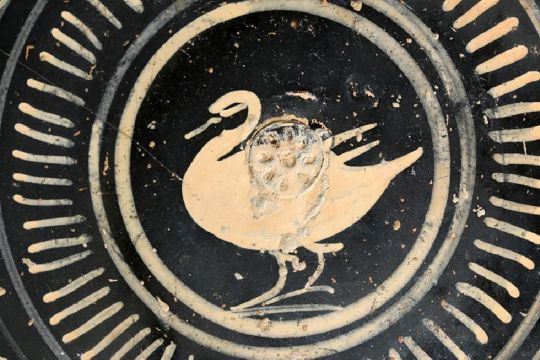
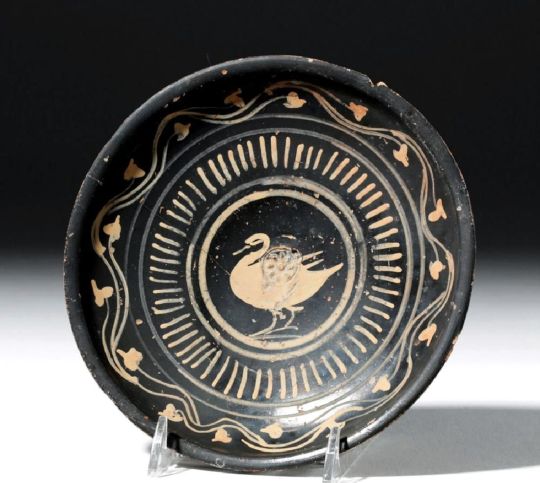
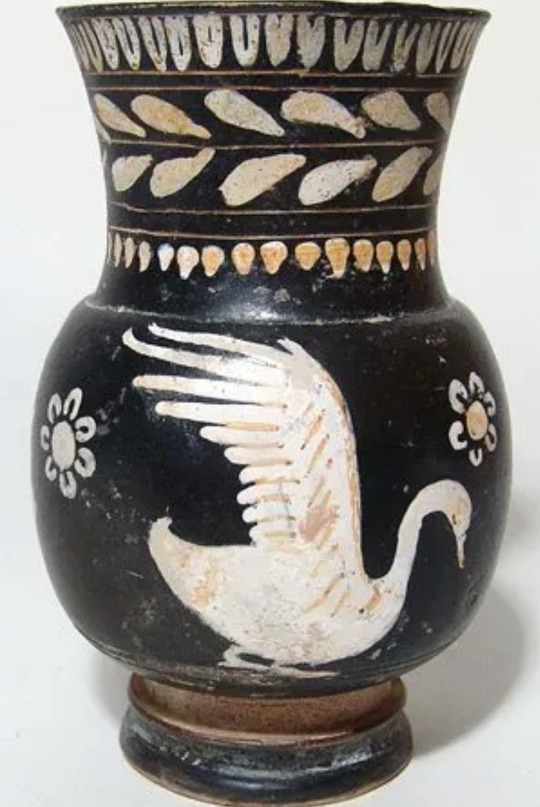

Swan skypos, southern Italy, Colony of Apulia, late 4th century BCE.
Swan plate, Magna Graecia, South Italy, Xenon, ca. 4th c. BCE.
Apulian Greek Olpe with swan, Magnia Graecia, c. 4th Century BCE
Apulian lekythos with swan, ca. 340 to 325 BCE.
215 notes
·
View notes
Text

aryballos, Eastern Mediterranean (possibly Egyptian), c. 6th-4th century BCE, glass
currently in the collection of the Yale University Art Gallery, accession no. 1955.6.237
143 notes
·
View notes